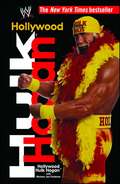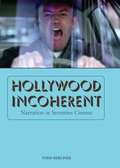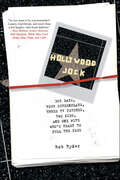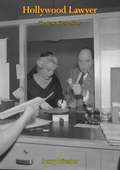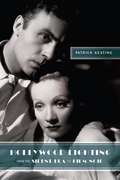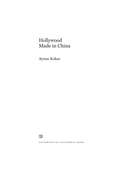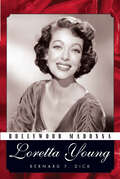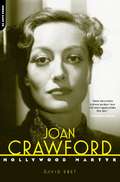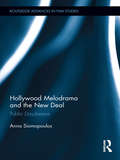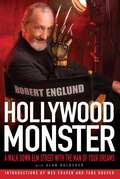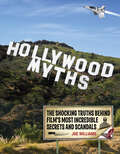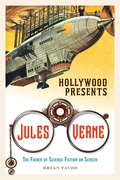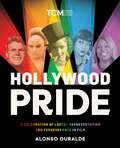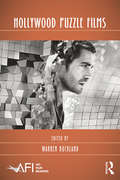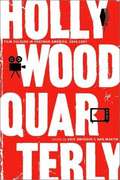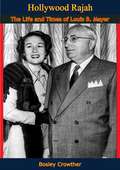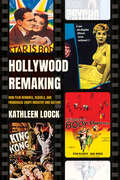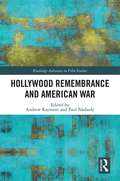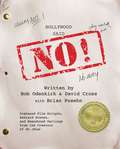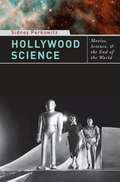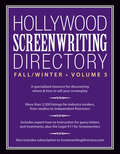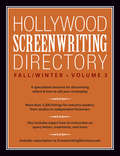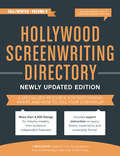- Table View
- List View
Hollywood Hulk Hogan (WWE)
by Hulk HoganYou think you know Hollywood Hulk Hogan ? Brother, you don't know squat about me. Yeah, I'm the towering red-and-yellow warrior who revolutionized the wrestling business, the larger-than-life superhero who transformed an entire country into a horde of Hulkamaniacs. I'm the guy who spit blood and breathed fire to help create an empire called World Wrestling Entertainment . But it wasn't always like that. Once I was a fat kid named Terry Bollea watching legends like Dusty Rhodes and Superstar Billy Graham, never dreaming I'd be a professional wrestler myself one day. Run with me on the streets of Tampa, where a bass guitar became my salvation. Fight alongside me in the wrestling arenas of Japan, where opponents try to bite your fingers off to make a name for themselves. Slide into the ring with me against 700-pound Andre the Giant, who only became my best friend after he found out he couldn't beat me down. Then cruise L.A. with me and Sylvester Stallone on the heels of Rocky III. Learn why Minnesota Governor Jesse Ventura hates my guts. Go head-to-head with Dennis Rodman in a hard-liquor drinking contest, and share a dressing room with Liberace. Find out what makes me cry like a baby, what makes my blood boil, what I think of Jesus Christ, and what scares the living hell out of me. Then tell me you know the man called Hollywood Hulk Hogan. Join the Babe Ruth of wrestling on a gritty, no-holds-barred odyssey from his start in the barbaric wrestling arenas of the seventies through the heartbreak of potentially career-ending surgery to the achievement of his greatest triumph yet. Along the way, lock up with the likes of Cyndi Lauper, Andy Kaufman, Dolly Parton, Mr. T, Ted Turner, George Foreman, Jay Leno, Undertaker, Triple H, The Rock...and of course, Vince McMahon, head of World Wrestling Entertainment . They're all in here, waiting to show you what they've got. Hollywood Hulk Hogan . It's the real deal, brother.
Hollywood Incoherent: Narration in Seventies Cinema
by Todd BerlinerIn the 1970s, Hollywood experienced a creative surge, opening a new era in American cinema with films that challenged traditional modes of storytelling. Inspired by European and Asian art cinema as well as Hollywood’s own history of narrative ingenuity, directors such as Martin Scorsese, Robert Altman, William Friedkin, Stanley Kubrick, Woody Allen, and Francis Ford Coppola undermined the harmony of traditional Hollywood cinema and created some of the best movies ever to come out of the American film industry. Critics have previously viewed these films as a response to the cultural and political upheavals of the 1970s, but until now no one has explored how the period’s inventive narrative design represents one of the great artistic accomplishments of American cinema. In Hollywood Incoherent, Todd Berliner offers the first thorough analysis of the narrative and stylistic innovations of seventies cinema and its influence on contemporary American filmmaking. He examines not just formally eccentric films—Nashville; Taxi Driver; A Clockwork Orange; The Godfather, Part II; and the films of John Cassavetes—but also mainstream commercial films, including The Exorcist, The Godfather, The French Connection, Willy Wonka and the Chocolate Factory, Dog Day Afternoon, Chinatown, The Bad News Bears, Patton, All the President’s Men, Annie Hall, and many others. With persuasive revisionist analyses, Berliner demonstrates the centrality of this period to the history of Hollywood’s formal development, showing how seventies films represent the key turning point between the storytelling modes of the studio era and those of modern American cinema.
Hollywood Jock: 365 Days, Four Screenplays, Three TV Pitches, Two Kids, and One Wife Who's Ready to Pull the Plug
by Rob RyderRob Ryder made that pledge to his wife, and he was determined to stick to it. As technical consultant on blockbuster sports films, he had seen up close how the film business works and what kind of chaos can, and usually does, ensue. And now he was ready to take it on!Hollywood Jock is the suspenseful, dramatic, outrageous, and honest true story of the year when Rob Ryder, screenwriter, laid it all on the line -- and kicked, scratched, wheeled, dealed, and fought like hell to hit the Tinseltown big time. It is a chronicle of schmoozing producers, shopping screenplays, corralling sports legends, and dodging irate actors -- a fascinating perspective on the highs, the very lows, and the behind-the-scenes madness that makes the world of Hollywood so endlessly compelling . . . and infamously brutal.
Hollywood Lawyer: The Jerry Giesler Story
by Pete Martin Jerry GieslerTHE ACCUSED IS ENTITLED TO A DEFENSE.Jerry Giesler believed the accused is entitled to a good defense. What he delivered, consistently, was a brilliant defense. Here are some of the people he defended:Errol Flynn—charged with statutory rape on two counts;Clarence Darrow—charged with attempted bribery of a jury;Lily St. Cyr—charged with indecent exposure;Charles Chaplin—charged with violation of the Mann Act;Robert Mitchum—charged with illegal possession of narcotics.The due processes of law make fascinating reading. When the cases are charged with the legal genius of a Giesler at work, the fascination cannot be denied!
Hollywood Lighting from the Silent Era to Film Noir
by Patrick KeatingLighting performs essential functions in Hollywood films, enhancing the glamour, clarifying the action, and intensifying the mood. Examining every facet of this understated art form, from the glowing backlights of the silent period to the shaded alleys of film noir, Patrick Keating affirms the role of Hollywood lighting as a distinct, compositional force. Closely analyzing Girl Shy (1924), Anna Karenina (1935), Only Angels Have Wings (1939), and T-Men (1947), along with other brilliant classics, Keating describes the unique problems posed by these films and the innovative ways cinematographers handled the challenge. Once dismissed as crank-turning laborers, these early cinematographers became skillful professional artists by carefully balancing the competing demands of story, studio, and star. Enhanced by more than one hundred illustrations, this volume counters the notion that style took a backseat to storytelling in Hollywood film, proving that the lighting practices of the studio era were anything but neutral, uniform, and invisible. Cinematographers were masters of multifunctionality and negotiation, honing their craft to achieve not only realistic fantasy but also pictorial artistry.
Hollywood Lighting from the Silent Era to Film Noir (Film and Culture Series)
by Patrick KeatingLighting performs essential functions in Hollywood films, enhancing the glamour, clarifying the action, and intensifying the mood. Examining every facet of this understated art form, from the glowing backlights of the silent period to the shaded alleys of film noir, Patrick Keating affirms the role of Hollywood lighting as a distinct, compositional force.Closely analyzing Girl Shy (1924), Anna Karenina (1935), Only Angels Have Wings (1939), and T-Men (1947), along with other brilliant classics, Keating describes the unique problems posed by these films and the innovative ways cinematographers handled the challenge. Once dismissed as crank-turning laborers, these early cinematographers became skillful professional artists by carefully balancing the competing demands of story, studio, and star. Enhanced by more than one hundred illustrations, this volume counters the notion that style took a backseat to storytelling in Hollywood film, proving that the lighting practices of the studio era were anything but neutral, uniform, and invisible. Cinematographers were masters of multifunctionality and negotiation, honing their craft to achieve not only realistic fantasy but also pictorial artistry.
Hollywood Made in China
by Aynne KokasChina’s entry into the World Trade Organization in 2001 ignited a race to capture new global media audiences. Hollywood moguls began courting Chinese investors to create entertainment on an international scale—from behemoth theme parks to blockbuster films. Hollywood Made in China examines these new collaborations, where the distinctions between Hollywood’s “dream factory” and Xi Jinping's "Chinese Dream" of global influence become increasingly blurred. With insightful policy analysis, ethnographic research, and interviews with CEOs, directors, and film workers in Beijing, Shanghai, and Los Angeles, Aynne Kokas offers an unflinching look at China’s new role in the global media industries. A window into the partnerships with Chinese corporations that now shape Hollywood, this book will captivate anyone who consumes commercial media in the twenty-first century.
Hollywood Madonna: Loretta Young (Hollywood Legends Series)
by Bernard F. DickLoretta Young (1913–2000) was an Academy Award–winning actress known for devout Catholicism and her performances in The Farmer's Daughter, The Bishop's Wife, and Come to the Stable, and for her long-running and tremendously popular television series. But that was not the whole story.. Hollywood Madonna explores the full saga of Loretta Young's professional and personal life. She made her film debut at age four, became a star at fifteen, and many awards and accolades later, made her final television movie at age seventy-six. This biography withholds none of the details of her affair with Clark Gable and the daughter that powerful love produced. Bernard F. Dick places Young's affair in the proper context of the time and the choices available to women in 1935, especially a noted Catholic like Young, whose career would have been in ruins if the public knew of her tryst. With the birth of a daughter, who would have been branded a love child, Loretta Young reached the crossroads of disclosure and deception, choosing the latter path. That choice resulted in an illustrious career for her and a tortured childhood for her daughter.
Hollywood Martyr Joan Crawford: Hollywood Martyr
by David BretIn the first fully uncensored biography of Joan Crawford, bestselling author David Bret follows Crawford from working in a Kansas City laundry to collecting an Oscar for Mildred Pierce, including details from her countless love affairs and her devotion toward Christian Science. Bret also divulges how her loathed mother forced her to work as a prostitute and use sex strategically, as well as what really led her to disinherit two of her four children, earning her the moniker "Mommie Dearest. ” Drawing on a wealth of unpublished material and interviews with stars like Marlene Dietrich and Douglas Fairbanks, David Bret presents a fascinating portrait of a single-minded, uncompromising woman.
Hollywood Melodrama and the New Deal: Public Daydreams (Routledge Advances in Film Studies)
by Anna SiomopoulosWhile many critics have analyzed the influence of the FDR administration on Hollywood films of the era, most of these studies have focused either on New Deal imagery or on studio interactions with the federal government. Neither type of study explores the relationship between film and the ideological principles underlying the New Deal. This book argues that the most important connections between the New Deal and Hollywood melodrama lie neither in the New Deal iconography of these films, nor in the politics of any one studio executive. Rather, the New Deal figures prominently in Hollywood melodramas of the Depression era because these films engage the political ideas underlying welfare state policies—ideas that extended the reach of government into the private realm. As the author shows, Hollywood melodramas interrogated New Deal principles of liberal empathy—consumer citizenship, the refeudalization of the state, and minimal economic redistribution—only to support welfare-state ideology in the end.
Hollywood Monster: A Walk Down Elm Street with the Man of Your Dreams
by Alan Goldsher Robert EnglundRobert Englund, legendary star of A Nightmare on Elm Street, peels back the Freddy Krueger mask and reveals the stuff of every horror buff&’s dreams.ONE...TWO...FREDDY'S COMING FOR YOU... You've seen him in the A Nightmare on Elm Street series—and in your darkest dreams. The sadistic killer with the flame-charred face. The knife-blade claws. The razor-sharp wit. Freddy...But you've never seen him like this. Unflinching. Uncensored. Unmasked. Meet Robert Englund, the award-winning actor best known for his role as Freddy Krueger—the legendary horror icon featured on the American Film Institute's "100 Greatest Heroes and Villains" roster—a character as unforgettable and enduring as Bela Lugosi's Dracula and Boris Karloff's Frankenstein. Now, for the first time, the man behind the latex mask tells his story in this captivating new memoir, published to celebrate the twenty-fifth anniversary of the first A Nightmare on Elm Street film. You see, Robert Englund is no monster at all, but a deeply funny, charming Hollywood veteran. Packed with Robert's hilarious stories, playful self-deprecation, and a generous helping of never-before-revealed A Nightmare on Elm Street trivia, Hollywood Monster offers an unparalleled look at the beloved film icon. With insider savvy and gallows humor, Robert recounts his audition for Wes Craven, the inspiration for Freddy's character, the grueling makeup sessions, his soon-to-be-famous costars, the often disastrous on-set blunders, and the wave of popularity that propelled this humble California surfer kid all the way to the top. Of course, fame and fortune as Freddy came years after the young actor shared a trailer with screen legend Henry Fonda, was punched in the face by Richard Gere, took down Burt Reynolds, and muscled his way between Arnold Schwarzenegger, Sally Field, and Jeff Bridges. But soon after his high-profile stint in the groundbreaking TV miniseries V, Robert Englund took on the most celebrated role of his career—the macabre and wisecracking killer who quickly became a household name. From the moment Freddy Krueger dragged his claws across a rusty pipe in the opening dream sequence, a legend had been unleashed—and a star was born. This is his story. "Welcome to prime time, bitch." —Frederick Charles Krueger, bastard son of a hundred maniacs
Hollywood Myths: The Shocking Truths Behind Film's Most Incredible Secrets and Scandals
by Joe WilliamsA film journalist’s insider account of the truth behind some of the movie industry’s biggest legends and scandals—a perfect gift for film buffs.Hollywood exists to create and sell myth. Often, however, the myths created on screen are secondary to the rumors, half-truths, and lies that circulate through studio back lots and the press. Discover the real stories behind Hollywood’s greatest myths, as veteran film critic and Hollywood reporter Joe Williams sorts fact from fiction and examines how these tales came to be and how they persisted. Did Thomas Edison really invent the motion picture? Why has Charlie Chaplin survived as the undisputed king of the silent era? What about Fatty Arbuckle and that ill-fated boys’ weekend in San Francisco? Did Woody Allen really marry his adopted daughter? Was there actually a suicide on the set of The Wizard of Oz (or are any of the other countless rumors about that film true)? The tales featured in Hollywood Myths involve specific films, actors’ private lives, the industry itself, and urban legends that have existed as long as Hollywood has. Throughout, Williams illuminates what it was that made the biggest stars—from Marlon to Marilyn, Bogie to Brad—shine so brightly on the silver screen. In all, 56 enduring myths are examined, in the process revealing the machinations of myth-making in the fast, loose, and out-of-control world of Hollywood.
Hollywood Presents Jules Verne: The Father of Science Fiction on Screen (Screen Classics)
by Brian TavesAn &“illuminating&” look at how filmmakers have taken us around the world, under the sea, and to the center of the earth over the course of a century (Milwaukee Express). Even for those who have never read Jules Verne, the author&’s very name conjures visions of the submarine in Twenty Thousand Leagues Under the Sea, the epic race in Around the World in Eighty Days, the spacecraft in From the Earth to the Moon, and the daring descent in Journey to the Center of the Earth. One of the most widely translated authors of all time, Verne has inspired filmmakers since the early silent period and continues to fascinate audiences more than a century after his works were first published. His riveting plots and vivid descriptions easily transform into compelling scripts and dramatic visual compositions. In Hollywood Presents Jules Verne, Brian Taves investigates the indelible mark that the author has left on English-language cinema. Adaptations of Verne&’s tales have taken many forms—early movie shorts, serials, feature films, miniseries, and television shows—and have been produced as both animated and live-action films. Taves illuminates how, as these stories have been made and remade over the years, each new adaptation looks back not only to Verne&’s words but also to previous screen incarnations. He also examines how generations of actors have portrayed iconic characters such as Phileas Fogg and Captain Nemo, and how these figures are treated in pastiches such as Journey 2: The Mysterious Island. Investigating the biggest box-office hits as well as lower-budget productions, this comprehensive study will appeal not only to fans of the writer's work but also to readers interested in the ever-changing relationship between literature, theater, and film.
Hollywood Pride: A Celebration of LGBTQ+ Representation and Perseverance in Film
by Alonso DuraldeFor generations, members of the LGBTQ+ community in Hollywood needed to be discreet about their lives but—make no mistake—they were everywhere, both in front of and behind the camera. On the eve of the twentieth century, in Thomas Edison&’s laboratory, one of the earliest attempts at a sound film depicted two men dancing together as a third plays the violin. It&’s only a few minutes long, but this cornerstone of early cinema captured a queer moment on film. It would not be the last. With Hollywood Pride, renowned film critic Alonso Duralde presents a history spanning from the dawn of cinema through the &“pansy craze&” of the 1930s and the New Queer Cinema of the 1990s, all the way up to today. He showcases the hard-working actors, writers, directors, producers, cinematographers, art directors, and choreographers whose achievements defined the American film industry and charts the evolution of LGBTQ+ storytelling itself—the way mainstream Hollywood decided it would portray (or erase) their lives and the narratives created by queer filmmakers who fought to tell those stories themselves. Along the way, readers will encounter a fascinating cast of characters, such as the first generation of queer actors, including J. Warren Kerrigan, Ramon Novarro, and William Haines. Early cinema pioneers like Alla Nazimova and F. W. Murnau helped shape the new medium of moving pictures. The sex symbols, both male (Rock Hudson, Tab Hunter, and Anthony Perkins) and female (Lizabeth Scott and Greta Garbo), lived under the threat of their private lives undermining their public personas. Underground filmmakers Kenneth Anger and John Waters made huge strides in LGBTQ+ representation with their off-off-Hollywood productions in the 1960s and &’70s. These screen legends paved the way for every openly queer figure in Hollywood today. Illustrated with more than 175 full-color and black-and-white images, Hollywood Pride points to the bright future of LGBTQ+ representation in cinema by revealing the story of the community&’s inclusion and erasure, its visibility and invisibility, and its triumphs and tragedies.
Hollywood Puzzle Films (AFI Film Readers)
by Warren BucklandFrom Inception to The Lake House, moviegoers are increasingly flocking to narratologically complex puzzle films. These puzzle movies borrow techniques—like fragmented spatio-temporal reality, time loops, unstable characters with split identities or unreliable narrators—more commonly attributed to art cinema and independent films. The essays in Hollywood Puzzle Films examine the appropriation of puzzle film techniques by contemporary Hollywood dramas and blockbusters through questions of narrative, time, and altered realities. Analyzing movies like Source Code, The Butterfly Effect, Donnie Darko, Déjà Vu, and adaptations of Philip K. Dick, contributors explore the implications of Hollywood's new movie mind games.
Hollywood Quarterly: Film Culture in Post-war America, 1945-1957
by Eric Smoodin Ann MartinA collection of essays from the Hollywood Quarterly, the first long running film and media journal in the United States which was founded in 1947 by lefty Hollywood filmmakers and Southern California intellectuals.
Hollywood Rajah: The Life and Times of Louis B. Mayer
by Bosley CrowtherHE DISCOVERED GARBO AND GABLE.FOR NINE YEARS HE WAS THE HIGHEST SALARIED MAN IN THE U.S.HIS LIFE SURPASSED ALL HIS GREATEST FILMS IN LUXURY, NOTORIETY AND TRAGEDY.HE WAS A MAN TO BE FEARED.First published in 1960, Hollywood Rajah: The Life and Times of Louis B. Mayer is the explosive biography of the head of MGM studio; the fabulous behind-the-scenes story of the most powerful of Hollywood’s famed tycoons, it is a story more fantastic than any ever brought to the screen.This is the extravagant life story of Louis B. Mayer, once head of the largest motion picture studio in the world, and the most controversial subject in Hollywood’s notorious history—a man who went everywhere, did everything, and knew everyone worth knowing. A man whose tapeworm ego had to be fed by driving activity, ruthless use of power, and adventures with beautiful women. Louis B. Mayer was a power to be feared, a man who deliberately surrounded and protected himself with myths and legends.Now his true story can be told.
Hollywood Remaking: How Film Remakes, Sequels, and Franchises Shape Industry and Culture
by Kathleen LoockFrom the inception of cinema to today’s franchise era, remaking has always been a motor of ongoing film production. Hollywood Remaking challenges the categorical dismissal in film criticism of remakes, sequels, and franchises by probing what these formats really do when they revisit familiar stories. Kathleen Loock argues that movies from Hollywood’s large-scale system of remaking use serial repetition and variation to constantly negotiate past and present, explore stability and change, and actively shape how the film industry, cinema, and audiences imagine themselves. Far from a simple profit-making exercise, remaking is an inherently dynamic practice situated between the film industry’s economic logic and the cultural imagination. Although remaking developed as a business practice in the United States, this book shows that it also shapes cinematic aesthetics and cultural debates, fosters film-historical knowledge, and promotes feelings of generational belonging among audiences.
Hollywood Remembrance and American War (Routledge Advances in Film Studies)
by Andrew Rayment and Paul NadasdyHollywood Remembrance and American War addresses the synergy between Hollywood war films and American forms of war remembrance. Subjecting the notion that war films ought to be considered ʻthe war memorials of today’ to critical scrutiny, the book develops a theoretical understanding of how Hollywood war films, as rhetorical sites of remembering and memory, reflect, replicate and resist American modes of remembrance. The authors first develop the framework for, and elaborate on, the co-evolution of Hollywood war cinema and American war memorialization in the historical, political and ideological terms of remembrance, and the parallel synergic relationship between the aesthetic and industrial status of Hollywood war cinema and the remembering of American war on film. The chapters then move to analysis of Hollywood war films – covering The Great War, World War II, The Korean War, The Vietnam War, The Cold War, and the wars in Afghanistan and Iraq – and critically scrutinize the terms upon which a film could be considered a memorial to the war it represents. Bringing together the fields of film studies and memory studies, this book will be of interest to scholars and students in not just these areas but those in the fields of history, media and cultural studies more broadly, too.
Hollywood Said No!: Orphaned Film Scripts, Bastard Scenes, and Abandoned Darlings from the Creators of Mr. Show
by David Cross Bob Odenkirk Brian PosehnBob Odenkirk and David Cross, creators of HBO's classic sketch comedy show Mr. Show, present to you this collection of never-before-seen scripts and ideas that Hollywood couldn't find the gumption to green-light. Simply put...HOLLYWOOD SAID NO!Since Mr. Show closed up shop, Bob and David have kept busy with many projects--acting in fun, successful, movies and TV shows, directing things, and complaining about stuff that didn't turn out well to anyone who would listen, and even alone, in silence, inside their own heads.HOLLYWOOD SAID NO! reveals the full-length, never-before-seen scripts for Bob and David Make a Movie (fleshed out with brand-new storyboards by acclaimed artist Mike Mitchell) and Hooray For America!: a satirical power-house indictment of all that you hold dear. This tome also includes a bonus section of orphaned sketch ideas from the Mr. Show days and beyond, suitable for performance by church groups that aren't all koo-koo about religion. What you are looking at online, and are about to buy, is chock-full of comic twists, turns, and maybe a few hard truths. We said "maybe," but what we mean was "probably not."Now, for the first time, take a peek at the scripts that didn't get the go-ahead and ponder a world we can only dream about...and beyond!
Hollywood Science: Movies, Science, and the End of the World
by Sidney PerkowitzWhether depicting humans battling aliens or a brave geologist saving lives as a volcano erupts, science-fiction films are an exciting visual and sensuous introduction to the workings of science and technology. These films explore a range of complex topics in vivid and accessible ways, from space travel and laser technology to genetic engineering, global warming, and the consequences of nuclear weaponry. Though actual scientific lab work might not be as exciting, science fiction is an engaging yet powerful way for a wide audience to explore some of the most pressing issues and ideas of our time. In this book, a scientist and dedicated film enthusiast discusses the portrayal of science in more than one hundred films, including science fiction, scientific biographies, and documentaries. Beginning with early films like Voyage to the Moon and Metropolis and concluding with more recent offerings like The Matrix, War of the Worlds, A Beautiful Mind, and An Inconvenient Truth, Sidney Perkowitz questions how much faith we can put into Hollywood's depiction of scientists and their work; how accurately these films capture scientific fact and theory; whether cataclysms like our collision with a comet can actually happen; and to what extent these films influence public opinion about science and the future. Movies, especially science-fiction films, temporarily remove viewers from the world as they know it and show them the world as it might be, providing special perspective on human nature and society. Yet "Hollywood science" can be erroneous, distorting fact for dramatic effect and stereotyping scientists as remote and nerdy, evil, or noble, doing little to improve the relationship between science and society. Bringing together history, scientific theory, and humorous observation, Hollywood Science features dozens of film stills and a list of the all-time best and worst science-fiction movies. Just as this genre appeals to all types of viewers, this book will resonate with anyone who has been inspired by science-fiction films and would like to learn how fantasy compares to fact.
Hollywood Science: Movies, Science, and the End of the World (Acs Symposium Ser. #1139)
by Sidney PerkowitzWhether depicting humans battling aliens or a brave geologist saving lives as a volcano erupts, science-fiction films are an exciting visual and sensuous introduction to the workings of science and technology. These films explore a range of complex topics in vivid and accessible ways, from space travel and laser technology to genetic engineering, global warming, and the consequences of nuclear weaponry. Though actual scientific lab work might not be as exciting, science fiction is an engaging yet powerful way for a wide audience to explore some of the most pressing issues and ideas of our time.In this book, a scientist and dedicated film enthusiast discusses the portrayal of science in more than one hundred films, including science fiction, scientific biographies, and documentaries. Beginning with early films like Voyage to the Moon and Metropolis and concluding with more recent offerings like The Matrix, War of the Worlds, A Beautiful Mind, and An Inconvenient Truth, Sidney Perkowitz questions how much faith we can put into Hollywood's depiction of scientists and their work; how accurately these films capture scientific fact and theory; whether cataclysms like our collision with a comet can actually happen; and to what extent these films influence public opinion about science and the future. Movies, especially science-fiction films, temporarily remove viewers from the world as they know it and show them the world as it might be, providing special perspective on human nature and society. Yet "Hollywood science" can be erroneous, distorting fact for dramatic effect and stereotyping scientists as remote and nerdy, evil, or noble, doing little to improve the relationship between science and society. Bringing together history, scientific theory, and humorous observation, Hollywood Science features dozens of film stills and a list of the all-time best and worst science-fiction movies. Just as this genre appeals to all types of viewers, this book will resonate with anyone who has been inspired by science-fiction films and would like to learn how fantasy compares to fact.
Hollywood Screenwriting Directory Fall/Winter Volume 3
by Jesse DoumaScreenwriting market intel you won't find anywhere else! Mailing out submissions based on some contact information you found on the Internet isn't going to get your script sold. What's truly valuable to an aspiring screenwriter is the kind of specific details you can only get through years of Industry experience. That's why The Writers Store compiled the Hollywood Screenwriting Directory, the product of more than three decades working directly with the people behind the world's favorite films. This targeted reference book features: Verified contact information for Hollywood buyers, including phone numbers, and street and email addresses. Crucial details like whether they accept unsolicited material and how they prefer to receive submissions. A guide to proper script format and advice on packaging your submission. Step-by-step instructions for writing professional query letters, treatments and tag lines. Plus, you'll find samples throughout, illustrated with tips and pointers to help you create a quality submission. With the Hollywood Screenwriting Directory by your side, you'll have a reliable resource that significantly ups your chances of script-selling success!
Hollywood Screenwriting Directory Fall/Winter Volume 3: A Specialized Resource for Discovering Where & How to Sell Your Screenplay
by Jesse DoumaScreenwriting market intel you won't find anywhere else! Mailing out submissions based on some contact information you found on the Internet isn't going to get your script sold. What's truly valuable to an aspiring screenwriter is the kind of specific details you can only get through years of Industry experience. That's why The Writers Store compiled the Hollywood Screenwriting Directory, the product of more than three decades working directly with the people behind the world's favorite films. This targeted reference book features: Verified contact information for Hollywood buyers, including phone numbers, and street and email addresses. Crucial details like whether they accept unsolicited material and how they prefer to receive submissions. A guide to proper script format and advice on packaging your submission. Step-by-step instructions for writing professional query letters, treatments and tag lines. Plus, you'll find samples throughout, illustrated with tips and pointers to help you create a quality submission. With the Hollywood Screenwriting Directory by your side, you'll have a reliable resource that significantly ups your chances of script-selling success!
Hollywood Screenwriting Directory Fall/Winter: A Specialized Resource for Discovering Where & How to Sell Your Screenplay
by Jesse Douma Dinah PerezTo get your screenplay in front of the right buyer, you need exclusive information and specific details you can only gain through years of industry experience. That's why The Writers Store has compiled the Hollywood Screenwriting Directory, the product of more than three decades working directly with the decision makers behind the world's favorite films. This invaluable reference features:Thousands of listings for Hollywood buyers, industry insiders, studios, and independent financiers, all with verifi ed contact informationCrucial details for submitting your screenplay to specific markets: how they prefer to receive submissions, and whether they accept unsolicited materialA guide to properly formatting your script and packaging your submissionClear, step-by-step instructions for crafting professional query letters, treatments, and log linesA Silver subscription to ScreenwritingDirectory.com (a $49 value)In addition, you'll find illustrated screenplay samples, essential legal information, and tips for creating a quality submission. With the Hollywood Screenwriting Directory at your fingertips, you'll significantly increase your chances of script-selling success!
